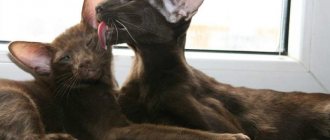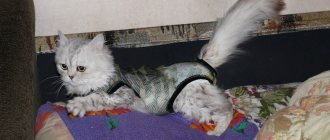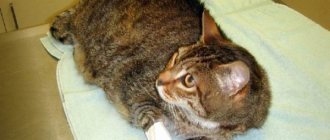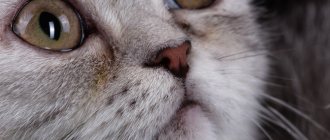A cat is a very soft and sweet pet that brings a huge amount of joy to every owner. But in addition to a lot of positive emotions, a funny little tiger can also cause a lot of trouble with its temporary problems. Any owner may be taken by surprise by the question of how many days a cat has been walking.
The animal may want to go free swimming due to the onset of puberty. Typically, in older individuals this process begins around the eighth month of life. This process depends on many factors:
- Breeds;
- Physique;
- Heredity;
- Living conditions;
- The presence of adults nearby.
At this time, the pet’s behavior may change dramatically; the cat becomes more active, aggressive and very persistently tries to leave the house. It's all due to hormones that force the beast to look for a “soul mate” for procreation. Not finding an outlet for its energy, a cat that is walking can spend it screaming incessantly day and night, attacking its owners and placing marks throughout the apartment. This means that the cat is ready for sexual intercourse.
To prevent this behavior, you can use special medications or resort to castration. But if you don’t like such methods, then you should stop at the simplest way to rid your cat of a hormonal storm and let him out for a walk. And here you need to know how often the cat walks.
© shutterstock
How long can a British cat go into heat?
In order to determine how long the period of festivities for a given breed can last, it is worth taking a closer look at the chronology of this event:
- When talking about how long a British cat’s estrus can last, they most often start from the moment of obvious signs such as uterine cries. In fact, it’s worth taking a closer look at the animal from the moment it eats more than usual, cuddles up to its owner, and often worries. In the British breed, like any other, this period usually does not last long - about a day or two.
- The next stage lasts on average 5-7 days. It was during this period that all the “heavy artillery” described above fell.
However, it should also be mentioned how long the very first heat lasts. It can be only 4-5 days. Therefore, in this case there is no need to worry - everything is within normal limits.
When does a cat want a cat for the first time?
In pets, puberty usually occurs between 6 and 10 months. Upon completion, the cat goes into heat for the first time. The animal demonstrates its readiness to mate in various pronounced ways:
- loud, inviting meow - the cat communicates its attempts to attract a potential partner by screaming and howling (how many days a cat screams when asking for a cat for the first time will depend on its individual characteristics);
- marks left on the floor of the apartment with a smell attractive to the cat (zoologists disagree about the secretions: some believe that the animal leaves them involuntarily, others deliberately so that the partner will find it along the “trail”);
- towards the owner, the cat usually begins to behave extremely affectionately - purrs and rubs against his legs, but sometimes, on the contrary, aggressively - hisses and attacks on the sly;
- Wanting to mate, the cat rolls on the floor and during periods of increased desire takes a special position: bends forward, lifts the back of the body, while pointing its tail to the side.
In addition, during this difficult period for her, the pet becomes indifferent to food - she eats rarely and little by little, or stops eating altogether. Also, observant owners may notice her frequent visits to the litter tray.
Escape Prevention
The departure of a beloved cat from home is accompanied by worries and worries on the part of the owners. Anxiety increases even more if the pet is absent for a long time. In most cases, escape can be prevented.
- In order not to lose your beloved pet during the mating season, you can resort to sterilization (castration). This operation is harmless and is performed in a veterinary clinic under general anesthesia. It makes it possible to rid the animal of attraction to the opposite sex.
- There are special medications (drops and tablets) for cats that interrupt sexual desire. But contraceptives do not always pay off. Also, it is worth considering that all medications have side effects. Therefore, before giving the drug, you should consult a veterinarian.
- Try to create conditions so that the pet cannot leave the house. Strictly monitor the front door; it is advisable to install a protective net on the windows.
Why do young cats leave home?
If a young male or female cat has left the house, the following may be added to the usual reasons for such departure:
Young cats don't have enough experience
A cat can easily run out of an open door or jump out of a window, rushing after an insect or a bird, or finally a cat. Such cases are not rare. Having run out of the house, he cannot find his way back or gets injured. If there is a road next to the house, then such a runaway young kitten may become a victim of a passing car. Lack of experience can also entail the danger of being attacked by a pack of dogs.
There was an unfriendly atmosphere at home.
When the atmosphere at home becomes tense, frequent quarrels or even fights occur, cats may also leave. It also happens that a cat feels dislike from someone in the family, and this may also be the reason that the cat wants to run away from home.
When does it happen for the first time?
The age at which cats begin to walk for the first time varies depending on the breed, health status and individual characteristics of the animal. In addition, the conditions of detention, genetic predisposition, season of birth, and the presence of a male nearby have an influence.
The norm is considered to be a period of six months to a year. If estrus begins before four months or does not begin until one and a half years, you need to contact a veterinarian. The cat may have serious disturbances in the functioning of the hormonal system.
Owners should keep in mind that the first heat does not mean that the cat is ready to bear and give birth to healthy offspring. Matings are prohibited during the first two or three heats. Pregnancy will be too serious a test for a young body and will most likely lead to complications.
Magnetic attraction
The Earth is covered in magnetic fields, invisible forces that repel and attract each other depending on whether they are positively or negatively charged. Magnetic fields originate deep in the planet's core and radiate out to the surface, where they are influenced by tides and other magnetic forces from space. Every place on the planet has its own unique magnetic signature, based on the strength of the field at a given moment in time and space. We humans may need a special tool to detect this, but many animals can find magnetic north using just their mind and body. Among these animals are cats.
Many scientists believe that magnetic compounds are connected to the cat's central nervous system, which uses them to create a sixth sense: magnetoreception. Magnetic connections point toward magnetic north, but they can also detect field strength information in any direction. Magnetoception is not just a compass, it is a full-fledged GPS system. It's not known for sure whether cats can sense magnetic fields, but if they can, it might help explain why they are such skilled navigators.
Protracted estrus
If a cat does not exhibit sexual behavior for more than a year or, on the contrary, it leaks for 10-15 days in a row, this may indicate a malfunction in the body. In the case of the absence of estrus, the cause will be either hormonal problems, or problems associated with improper feeding and care, and this can also happen if the cat grew up without knowing what other felines are, or if there is little food in the room where she lives. Sveta.
Prolonged estrus may indicate ovarian pathologies, especially the presence of cysts and tumors. If this happens, this is an indication for castration. In addition, breeders noticed that the presence of a man in the house aggravates the estrus. No, it doesn’t have to be a cat, a human man is enough. Cats sense that this is also a male, which stimulates their sexual desire.
How many days do cats ask for a cat?
If we talk about how many days a cat wants a cat, then the time varies for all individuals. For the first time, the pet usually walks for 5 to 7 days. There are animals that go into heat twice a year, but more often there are more active ones, “walking” once every 3-4 weeks with a heat duration of up to 10 days or more. Of course, all terms are individual and depend on the age and health status of the pet. The older the cat gets, the less often she begins to “flow” and want to mate.
In addition, many owners are interested in how many days a cat walks in March, since it is during this month that the animals’ reproductive instinct becomes more acute, and they often disappear from home. Usually this period lasts from 3 to 5 days, but it can drag on.
Stages of estrus in cats
Estrus is divided into 4 phases. Even an experienced owner will find it difficult to distinguish one period of estrus from another. However, knowing the physiological characteristics of the mustachioed tabby, it will be possible to calculate a favorable date for mating, as well as avoid unpleasant incidents.
- Proestrus. This is the preparatory phase. It lasts from 1 to 4 days. You may notice changes in your cat's behavior. The pet rolls around on the floor, caresses its owner, and the first scanty discharge appears. At this stage, the female will not allow the cat to approach her, since she is not yet ready for fertilization.
- Estrus. The second stage is called the same as the entire cycle. The estrus itself lasts from 5 to 10 days, which largely depends on the breed. Under the increasing influence of hormones, it is already difficult for the cat to control its behavior - it screams day and night, and when stroked it takes a position characteristic of mating. Transparent discharge becomes noticeable. Planned mating or spontaneous mating occurs precisely during this phase.
- Interestrus, metestrus or post-estrus. The third period can take place according to several scenarios, depending on how the previous stage ended. If the cat had mating, during which fertilization occurred, then pregnancy occurs during metestrus, and after 60-70 days kittens will be born. There are cases when conception does not occur during sexual contact, and the pet develops a false pregnancy. This condition resembles a normal pregnancy in its symptoms, but does not end with childbirth and goes away after 30-45 days. If the cat has not had contact with a male, then over the next 2-15 days the attraction fades, interest in the opposite sex gives way to aggression.
- Anestrus. The final phase is called the rest period. The pet behaves in its usual way. The duration of anestrus can range from 3 weeks to several months. A cat that has given birth will have a longer period of calm than a cat that has not found a mate.
Sterilization
A pet during the “hunt” can cause a lot of inconvenience to its household members - the animal does not let you sleep and screams at night. And in the future, if it is not planned to breed her regularly, empty heats can greatly harm the cat’s health: such animals often develop various inflammatory processes in the reproductive organs, neoplasms and cancerous tumors.
You should not use chemicals that regulate sexual desire - they will do much more harm than good. Various herbal remedies can come to the aid of owners, however, the effect of their use is quite short-lived - furry beauties quickly get used to them and stop reacting.
In rare cases, it happens that a cat walks after sterilization. This happens in a situation where the animal has not completely removed all the ovarian tissue or left the uterus, and the necessary hormones continue to be released. To determine the cause, you need to take hormone tests - the animal may need another operation.
How does a female feel during estrus?
Estrus or estrus occurs in three periods. The furry pet experiences each stage in its own way:
- Proestrus. The initial stage lasts about three days. At this time, hormones are released that prepare the animal’s body for mating and fertilization. These days, the cat walks with its knees bent, rubs against its owner’s legs and demands his attention. From time to time he begins to behave restlessly. She is not yet ready to mate, and therefore vehemently rejects the cat.
- Estrus. This is the most successful period for breeding animals. The female begins to actively invite the male. She is literally shaking from the inability to realize her instinct. The pet is experiencing real agony. Therefore, at this time you should not scold your pet under any circumstances. The period lasts about a week.
- Interestrus or meestrus. The stage lasts from two to ten days. If at this time a cat is brought together with a cat, then after ovulation sexual activity quickly decreases and disappears completely. After this, females begin to treat males aggressively. If ovulation occurs without fertilization, the cat may experience a false pregnancy. If there was no mating, the cycle will soon begin again.
- Anestrus. The animal returns to normal life and begins to experience sexual rest. This period usually occurs during the winter months.
We suggest you read: Vaseline oil for kittens, how to give dosage
The behavior of each individual during sexual activity is individual. But basically the behavior of females during estrus is approximately the same:
- Cats scream as if they are in pain, when in fact they are not in pain. Most often, periods of screaming occur at night, morning and late evening.
- The animal may lie flat, purring quietly, or be completely silent.
- The cat actively rubs against various objects.
- It scratches, bites, that is, it shows aggression.
- He goes to the toilet quite often.
- Refuses to eat completely or eats very little.
- Walks on half-bent legs with the tail held to the side.
- She licks under her tail several times a day as her vulva (external genitalia) swells and secretes a clear-colored secretion. Cats do not produce blood during estrus.
- The animal obsessively demands affection, literally not leaving the owner.
- Shows an abnormal interest in animals and male people. Sniffs their clothes and shoes.
- When stroking the area of the sacrum, it moves its tail to the side and squats, sticking out its butt.
Drops and tinctures
Most often, experts recommend using the following drops:
- "Stop stress";
- "Suprastin";
- "Anti-stress";
- "Cat Baiyun".
All of them are made from herbs. With their help, you can normalize the nervous system and relieve stress. The drops are quite harmless, however, their long-term use can lead to decreased immunity and disruption of the nervous system.
Pills
Contraceptives have a short-term effect, regulate the frequency of rutting and reduce libido. The most popular and effective tablets are:
- "Perlutex";
- "Anti-sex";
- "The ex";
- "CounterSex";
- "Stop-intimate";
- "Sex barrier";
- "Gestrenol".
Hormone injections are the most effective and, at the same time, the most dangerous method. Long-acting contraceptives relieve symptoms for six months or more. The most common of them are: Depo-Provera and Covinan. After their use, side effects may occur in the form of weight gain, lethargy, swelling of the mammary glands, purulent inflammation of the genital organs, ovarian cysts, and pyometritis. Experienced specialists prescribe such drugs only to those individuals who, for some reason, cannot undergo sterilization.
Reasons for escape: what is the provocateur?
Mystical
Many people believe that cats are human protectors. If a cat comes to your doorstep, you cannot shoo it away. This has long been considered a blessing from above. A fluffy ball entering your home is a good sign. There are certain signs why cats leave and do not return, some of them:
- Impending trouble. If the cat has escaped, it may have sensed them and wants to avoid them. And, conversely, animals attract negative energy, so cats leave home to take it with them, away from their owner.
- Death. When there is a very sick person in the house, pets run away to take death with them. It is believed that this means the imminent death of the person who has fallen ill.
- Negative energy in the home. If the cat ran away from the house, it means that there is a lot of magical energy in the house or it is cursed.
The cat ran away to die
These are amazing animals that sense death. When old age sets in or a cat is sick, the owners know that she will soon go to another world, and they want to spend her last minutes next to her. Cats run away a few days before they die. They want to find solitude, they die away from prying eyes, so it’s easier for them to come to terms with the inevitable. Another, opposite opinion: cats do not want to bring death to the house and owner, they try not to upset their loved one.
Owner's behavior towards the pet
Frequent quarrels and scandals in the family are prerequisites for the pet to leave such housing. Cats are wonderful psychologists. The domestic cat senses people well. If one of the owners does not love him, then he goes far from home, for a long time or forever. If there are constantly scandals between family members, the pet simply cannot withstand such a flow of aggression. If an offended cat left home and did not return, this means that he was shouted at or even beaten. It happens that animals simply do not take root in a new home.
Zealous feelings
If a person gets other pets or a small child appears in the family, the cat may feel that a replacement has been found and kicked out. Feelings of loneliness and jealousy take over, and such cats do not stay at home for long
However, it also happens that the cat does not leave its beloved owner, cuddles, trying to draw all attention only to itself
Other reasons to be absent
- Prenatal condition and pregnancy. Before the kitten arrives, the mother cat goes looking for a place to give birth and runs away from the house. Some females go to abandoned dachas and will sit there for a certain time. When the kittens begin to walk on their own, the cats come back with the babies.
- Mating season. In the spring, perhaps the cat ran out of the apartment to go for a walk. Cats also walk. When the mating season has passed, they will return to their previous home, and the females will most likely return already pregnant.
- Longing for the former owner. The animal is also very upset when the person to whom he was most attached dies.
The main signs of a cat's heat
To prevent the pet from taking its owners by surprise, it is recommended to familiarize yourself with the signs of estrus in advance. The owner will immediately notice changes in the pet’s behavior, and drastic ones at that.
A walking cat is prone to affection
During heat, the cat becomes restless and sleeps less. She becomes overly affectionate, rubbing herself against her owners or furniture. During this period, the owner will definitely hear a piercing meow, loud rumbling or purring. All this is accompanied by a raised or sideways tail and an arched back. In the last few days, the cat may begin to squat, roll on its back, or lift its butt. The cat walks differently.
Note! Estrus is divided into three periods - proestrus, estrus and metestrus. Each of them takes from 2 to 5 days
Behavior changes depending on the stage of estrus.
There is no need to be afraid of loss of appetite; this is a common symptom when a cat is walking. The most active ones may scratch the walls or attempt to escape from the house to the street. The animal will be ready for mating only on days 2-4, when the estrus period begins. Only at this stage will she let the cat near her. If fertilization has occurred, then during the metestrus stage all instincts will disappear: she will stop screaming and worrying.
Despite the fact that estrus is usually accompanied by bouts of affection and tenderness towards the owner, it is stressful for the animal, especially for the first time. A pet who is walking for the first time may show causeless aggression towards others. Her emotional state leaves much to be desired: anxiety and irritability affect her behavior. In some individuals, the state of tenderness and complaisance will periodically be replaced by attacks of anger throughout estrus.
how many days can a cat not come home in March
The cat hasn't come home for a week. Is there any hope that he will return?
I have two cats, they are 8 years old. I love them very much, I'm used to them. We live in a private house, now it’s spring for the cats, it’s impossible to keep them in the house, we let them out into the street. Sometimes they disappear at night and only come in the morning. But they always come, all 8 years! And a week ago one of the cats didn’t come. At first they thought he was just having a spree and would come in a day or two, but he still wasn’t there. And the hope is fading that he will return. Where can you live like this for a week, what to eat, etc.? Your imagination paints terrible pictures. Is it possible for a cat to return home after a week or more?
I’ve been walking for 3 weeks, I thought I’d already lost my cat, it was spring, a skinny skinny guy came and left lived in trust, that’s what sex can lead to
as I understand you. my cat is 17 years old, he keeps going for walks, the last time he was gone for 5 days. he was just sick. We treated him with antibiotics. I thought I was going to die, I was crying. no, he came. It starts like this every year, closer to spring. and walks at night. I worry every time, he’s already old after all. hope is the author. and I was walking for 2 weeks, so wait.
The author is very likely to return. My aunt’s cat in the village was very sick. Suddenly he is nowhere to be found. A few months later (. ) there was such a loud and demanding meow outside the door)))) The handsome man was sitting alive and well and also with a rat as a gift))) It was such happiness) They thought that he was probably cured with herbs in the forest, nature helped. there seem to be no more options. So be sure to wait
And pay attention, there may be places where you could fall/fall/climb, etc.
and can’t get out. Cats are curious.
My cat ran away like this 3 years ago in the spring. I was just gone for 3 weeks, then I came running myself. I was sitting on the window. and after some time it became clear that she was deeply pregnant)) Author, der
Source
How many days does it take to walk for the first time?
If a cat has started her first heat, this does not mean that her body is fully formed; everything should proceed like in all healthy females. The duration depends on the same internal and external factors, and especially on hormonal levels. Usually the first time a cat walks for 5 days. The normal duration in adult females is 5-10 days. If estrus lasts about 20 days, you need to show the cat to the veterinarian. This situation may mean a hormonal imbalance, the presence of a cyst, or diseases of the reproductive system. In rare cases, estrus for 20 days is considered normal.
Why cats leave home and never return: 5 reasons
If dogs are attached to the pack and the leader, then cats have a passion for the territory they inhabit and mark. This is the tradition of wild ancestors, fixed by evolution in the instincts of domesticated animals. Despite the fact that the cat is fed in the owner's house, sometimes it leaves and disappears for a while or forever.
Most often this happens for the following reasons:
- Instinct of procreation. The cat is in heat and disappears in search of a mate. The same thing happens with cats. Smelling a leaking cat, the pet disappears. He has to withstand competition. This is not always possible. In some cases, you have to hide and lick your wounds.
- The need to lamb in a safe place. Some cat owners don't like it when an animal gives birth at home, especially somewhere in a closet or on a bed, and soils bedding or clothes. The female finds a secluded place, preferably a closet with mice, and raises kittens. When the babies are able to walk, the cat brings the litter home, in the hope that the owner will take care of the kittens. If a temporary shelter is located nearby, the mother drags two or three-day-old cubs into the home one at a time.
- The hunting instinct overcomes young cats and females. Animals can leave in the evening, be absent all night and return in the morning. But sometimes cats get caught in a trap. The owner or neighbor closes the barn door, not suspecting that a hunter is sitting there. If there are enough mice, the captive may be able to feed for a long time.
- Competition: When a new pet comes into the house, a struggle for primacy develops between individuals of the same sex. When the weak does not obey the strong, he leaves.
- The cat is sick. This most often happens to older animals before death.
Be sure to read: How to scare cats away so they don’t shit, mark or damage furniture, what smell they can’t stand
Sometimes pets fall out of the window, and the way home is blocked by unforeseen obstacles. Young, inexperienced animals are curious and can go quite far in search of adventure. They are ok with orientation, but on the way back they may encounter dogs or fellow hooligans. To escape, the cat climbs onto a tree or roof, but is afraid to get back down. Finally, if an animal falls from a height, it can be injured.
Popular superstitions attribute fantastic reasons to the disappearance and return of cats, but real facts, not speculation, are of practical importance.
Memo for the owner
As the animal enters sexual maturity, we have new concerns. You need to know not only how long the cat’s first heat lasts, but also about the physiological characteristics of your pet. In particular, that it is forbidden to bring a cat to a young cat. Individuals no younger than one year old are allowed to reproduce. Early labor can be too difficult and even cause the death of the mother.
If mating has taken place, consult your veterinarian. You can carry out sterilization and solve the problem with this and subsequent offspring. If the cat is valuable for breeding, then the pregnancy must be monitored using an ultrasound, and it is advisable to invite a veterinarian to the birth (in case of complications).
Lost!
But what to do if your cat is lost and never leaves the house? As a rule, such pets are not adapted to the street. They are too trusting, do not see danger, and are not aware of the intentions of dogs and other cats. A pet can get hit by a car after dozing off on the edge of the road
Since you need to find a lost cat as quickly as possible, you should not postpone your search until tomorrow in the hope that it will return on its own.
It is important to know how to find a cat on the street. And for this you need to remember everything about the behavior of these animals
Firstly, cats are loners, so the domestic cat will seek solitude. Secondly, they are extremely attached to the territory, so the pet will not go far of its own free will. And thirdly, a cat that is scared prefers to hide rather than fight potential enemies. So, what to do if your cat is lost:
Since it is easier to find a cat on the street if the owner has help, you should immediately inform friends and relatives about the problem. You need to look for a fugitive by breaking into pairs and dividing the territory between groups. If it was not possible to find your pet during the day, the “search operation” is scheduled for late evening or early morning of the next day - a calm, quiet time when the cat is less frightened and more willing to respond to the call.
It's time to connect word of mouth. Distribute high-quality photographs of your pet to your helpers. Pictures should be shown to children, pensioners and teenagers (people who spend a lot of time outdoors and almost certainly have free time). Explain to them how to find a lost cat (ask them to look around the yard, bushes, trees, look under cars, etc.). The most important thing is to promise a reward and don’t forget to leave a piece of paper with contact information. Explain that the cat is lost and is not adapted to the street, and that it must be returned home before it gets into trouble. Typically, older people and children show sincere sympathy and really help in the search.
The next step is to notify the local population. Again, monetary rewards should definitely be mentioned. Advertisements should be posted along the search path (in an expanding spiral) and posted on the Internet. In the ad: a photograph (an ad without a photo does not work, it has been verified many times by hundreds of owners), special features, gender, contact information and a mention that the cat is domestic. It would be a good idea to look at advertisements about found cats printed in local newspapers. Messages about foundlings can be seen on the doors of pet stores and near veterinary clinics (you will still have to go there to hang up your missing notices).
If the cat is purebred, talk to doctors at local clinics, leaving them with contact information and a photo of the cat. On the back of the photo write gender, age, special features. People who find a purebred pet do not always voluntarily return the assigned cats and dogs, but at some point they will have to visit a veterinarian who can recognize the missing cat and report the find to the real owners.
How to recognize that your pet is asking for a cat?
It is clear at what age cats begin to walk. But how to recognize this period? It's actually very simple. The owner will not be able to confuse this with anything else. The greatest sexual activity of cats is observed in the first months of the year: from February to April. But in October-November, the cat shows less pronounced readiness to mate. You can understand that a cat is asking for a cat based on certain signs.
How a cat behaves when it wants a cat is described below:
- Often, representatives of the cat family have a decrease in appetite during this period. And some individuals completely lose interest in food. Of course, this may also indicate that the pet is sick. Therefore, this sign should not be considered separately as an indicator that the animal is walking. Estrus is necessarily accompanied by other symptoms.
- The pet begins to scream and meow loudly. At first it may look very unusual. Therefore, when a cat starts asking for a cat for the first time, it may seem strange to the owner. But this is all natural - the cat's instinct kicks in. Thus, the pet attracts a potential cat to mate.
- The animal begins to leave marks throughout the house. Therefore, the answer to the question of whether cats mark territory like cats is a resounding “yes.” During the period of estrus, the pet begins to have special discharge. Some people believe that a cat leaves marks on the floor involuntarily. Others are convinced that in this way she attracts a male. But there is also an opinion that a cat during estrus marks the boundaries in this way, fearing that the cats will lay claim to her territory. Regardless of the actual cause, discharge in a cat during heat is normal.
- The pet becomes overly affectionate: it purrs loudly and rubs against the owner’s legs. True, in some cases aggression may be observed in her behavior.
- The pet begins to go to the toilet often in small ways. But why did the cat start peeing anywhere during her heat? This is due to physiological changes in the body.
- The animal begins to take characteristic positions for mating: it lowers itself on its front legs, and raises the back of its body, moving its tail to the side. Thus, the cat makes it clear to the male that she is ready for mating.
All these signs indicate that the pet has begun to walk. This is why a cat meows for no reason, rubs its legs and eats poorly. But soon this period will end, and the pet will become calm again.
You can simply determine the duration of estrus by observing your cat. But, as a rule, this process lasts about 10 days. Of course, some factors can also influence this period, reducing or increasing the time of estrus. It should be noted that if you do not breed the cat or do not take measures to calm her down, after 2 weeks the estrus may happen again. Read the article “How many days does a cat ask for a cat and how to calm her down?”
Do cats come home after they run away?
If your cat ran away simply because she wanted adventure or to mate, she will come home again. Moreover, if you have already experienced your cat going missing once and then returning home, you can be sure that she will come home again.
However, in some cases, such as if your cat ran away due to changes in the home environment, or in the worst case scenario, she was involved in a fatal accident, she will not return.
© shutterstock
Methods of castration
All surgical methods of castration are divided into bloody and bloodless. Bloody methods are classic operations, which in turn are divided into two types: open and closed operations. Bloodless methods are so named because the scrotum is not opened during the operation, and castration occurs by destroying the vas deferens, the appendage of the testis, or the testis itself.
Public method
Open castration is the main method. The scrotum is stretched so that the skin is well stretched over the testes. An incision is made parallel to the body, cutting through the skin and the general vaginal membrane. The testis is taken out and the common tunica vaginalis is cut off from the epididymis with scissors.
Holding the testis with one hand, the other hand pulls the scrotum to the inguinal ring so that the spermatic cord can be extracted as much as possible. A ligature is placed on the cord as close to the ring as possible. The cord is cut a centimeter closer to the testis. Then the wound is sutured. The second testis is removed in the same way.
Private method
Closed castration is used for animals with an intravaginal hernia or with wide inguinal rings, as well as for old cats. The scrotum is stretched so that the skin is well stretched over the testes. Only the skin is cut so that the overall tunica vaginalis remains intact. After which the latter is disconnected from the wall of the scrotum.
Then the common vaginal membrane together with the testis is turned 180°C, stitched with a silk thread and a ligature is applied as close to the inguinal ring as possible. Then the testis and appendage are cut off a centimeter below. The wound is then sutured. The second testis is removed using the same method.
Vasectomy
Sterilization using a gentle method involves partial bilateral destruction of the vas deferens, as a result of which the animal’s sperm do not enter the penis. In this case, the vessels and nerves are not touched, which is why the testes continue to function, and the animal survives the operation much easier.
Advantages:
- The testes continue to function.
- No major surgery is required.
- General anesthesia is not needed; local anesthesia is sufficient.
Flaws:
- Great cost.
- Careful care is required after surgery.
- Not all veterinary surgeons can perform a vasectomy.
- The cat will not stop marking his territory and behaving aggressively.
Non-surgical options
There are a number of non-surgical methods of castration without removing the testicles:
Castration by irradiation. It assumes the effect of radiation on the testes and appendages of the animal, which leads to an immediate decrease in sexual activity. The dose is chosen on a personal basis, based on size and age. It is not used now because testicular cancer often occurs after irradiation.
Chemical castration. Substances based on megestrol acetate are injected into the cat's body by injection or orally in tablet form. The drug has a great influence on the regulation of sexual behavior and suppresses sexual desire.
Chemical castration on implants. A method of suppressing reproductive capacity with the prospect of further resumption. A Suprelorin implant is injected into the skin. There is no allergy to the implant, since it is biologically inactive. The main active ingredient is deslorelin, which reduces sexual desire over a long period. Infertility appears 6 weeks after the injection. The use of implants is not popular enough due to limited production and significant price.
Microwave castration. Castration occurs when exposed to microwave rays. The result in this case, as with the surgical method, will become eternal. Microwave irradiation also requires anesthesia, since this process, although painless, requires long-term and absolute immobility of the cat. The method has been tested on farm animals, but has not yet gained popularity in veterinary clinics, since there are no studies on long-term consequences, and a microwave emitter is also required.
Advantages of chemical methods:
- Reversibility of the result.
- No preparation needed.
- There is no rehabilitation period.
- There is no risk with anesthesia.
Flaws:
- Reversibility of the result.
- It is necessary to constantly monitor the intake or effect of the drug.
- The risks have been little studied.
Alternative ways to resolve the heat issue
Modern pharmacology can offer pet owners to discourage their animals from any desire to flirt with the opposite sex, preserving their reproductive function. In this case, it is proposed to use two types of drops:
- Sedatives (in addition to ready-made pharmacy options, you can use folk methods in the form of chamomile or thyme decoctions);
- Hormonal (they will calm a walking animal by adjusting the animal’s hormonal levels).
If the animal is not valuable as a breeder, it is better not to torture it and castrate the cat. Unlike people, animals do not grieve over the loss of the opportunity to bear offspring, so the pet will not receive any mental trauma, but only peace for itself and its owners.
Cute kittens evoke affection among their owners. You want to admire them; it’s nice to play with the fluffy balls. However, babies grow quickly and become adults. The most striking stage in kittens growing up is puberty. Their behavior changes dramatically under the influence of sex hormones.
At what age do cats start walking? How can you tell if a female is in heat? How many days does a cat ask for a cat? How to calm your pet and reduce the duration of estrus? At what months can cats give birth?
Main reasons
There are several reasons for this phenomenon. Usually they are based on instincts and behavior patterns provided by nature.
Sexual hunting
Young cats most often leave home in the spring due to sexual heat. Due to changes in hormonal levels, their body requires mating with a cat. At such moments, neither windows, nor doors, nor high fences can stop the pets. They go in search of their soulmate. Usually cats do not return home until the partner agrees to contact. If absent for a long time, the animal may become lost in space and time and not find its way home. Cats also sometimes leave the house to satisfy their natural needs. After a spree during estrus, get ready for the appearance of kittens soon.
Curiosity
Cats are inquisitive animals. This especially applies to kittens and young pets who are exploring the world around them.
Their attention is easily attracted by any objects and actions: a leaf falling from a tree, a butterfly or bug on the window, a rustling branch, etc.
In a fit of curiosity, the cat forgets about caution. He may jump out of a window or run outside the area in pursuit of an object, and only after a while discover that he is in an unfamiliar place
Sometimes finding your way home doesn't become impossible. An angry dog that chases the cat can make the situation worse. At first he experiences severe stress, and then gradually comes to his senses and looks for a new place to live.
He may jump out of a window or run outside the area in pursuit of an object, and only after a while discover that he is in an unfamiliar place. Sometimes finding your way home doesn't become impossible. An angry dog that chases the cat can make the situation worse. At first he experiences severe stress, and then gradually comes to his senses and looks for a new place to live.
Unfavorable atmosphere
Cats react acutely to the situation in the house
Most representatives love attention, care and affection from their owners. If an animal is beaten or abused in other ways, there is a high risk that it will wander away from home.
If there is an unfavorable atmosphere in the house, for example, frequent scandals, disagreements between family members and other problems, the pet will go in search of another place to live.
Loneliness
If other animals (puppies or kittens) appear in the house, the owners’ attention usually switches to them. The cat experiences loneliness, feels unwanted, so it leaves home in search of a better life.
A similar situation can arise at the birth of a child.
Before death
Furry pets often leave their homes before their death. To understand why cats leave home to die, it is necessary to study the behavior of their wild relatives. Lions are considered the strongest and largest representatives among cats. They live in prides. Young lionesses and lions obtain food and care for their offspring, providing them with protection from other predators.
When an animal begins to get sick or grow old, it cannot fully perform its duties, so it has to eat leftovers. Due to its weakness, it becomes a target for hyenas and other predators. In order not to bring trouble to the entire pride, sick and old lions and lionesses voluntarily leave the “family”. This way they give way to the young and protect them from attacks by predators. Natural instincts sometimes awaken in cats, and they leave their family and owners in order to protect them from perceived danger.
There is another explanation why cats leave home before they die. Some scientists believe that pets look for a secluded place to restore their strength and then return back. Although in most cases they go to Rainbow in a secluded place, and the owners do not even manage to find their corpse for burial.
When cats can't get home
Although it is common knowledge that cats are excellent navigators, this is not true for every individual cat. Some cats have trouble simply finding their way around the house, let alone navigating the outside world. This is especially true for domestic cats. An indoor cat that gets lost will not know in advance how to return to its territory, or how to avoid the dangers that await it on its way home.
Outdoor cats tend to be much better at finding their way home due to experience. A cat that is let out for a walk is an expert in how to get home. Wildcats in particular tend to have exceptional homing skills when needed. They are truly experts at crossing their territories to find food and shelter, and any cat that cannot do this will not live long enough to continue its breed. Thus, breeding in the wild occurs between the most experienced feline trackers, who then pass on their talents and knowledge to the next generation.
Deciding your future fate
If the cat is not sterilized and not satisfied over and over again, its hormonal levels will accumulate and sooner or later lead to a real explosion. The heats will come one after another at short intervals, sometimes just a couple of weeks, and then they will respond with terrible diseases - inflammation and cancerous tumors. This process can be accelerated by taking hormonal pills or injections, which do not solve the problem, but only interrupt the estrus, after which the next one comes even faster.
Yes, there are cats that live for 20 years - non-sterile and virgins. They flow as expected: several times a year and without any problems. And they take hormonal pills. And they are healthy almost until death, but they die, as they say, of old age. There are such examples, but these are exceptions. In most cases, the situation develops differently, as described above.
Hence the conclusion: either the cat must walk all the time and bring kittens, or she must be sterilized. To some, such a solution may seem inhumane, but, in fact, the cat will not suffer from an inferiority complex due to the fact that it cannot become a mother. But endless empty heats are physiological and emotional stress that causes severe suffering.
Author of the article Ekaterina Yugosh
– editor of the “Murkotiki” website, a journalist with a felinological education (a felinologist is a specialist who studies cats). She received her felinological education according to the WCF (World Cat Federation) system. She raises a Scottish Straight cat and a Highland Fold cat, as well as a Miniature Schnauzer dog. Her areas of in-depth interests include zoodietology and zoopsychology.
The period when cats begin to estrus indicates the maturation of the animal, its readiness to copulate and bear cubs. Mating of these animals occurs at the time when the female begins to estrus. In a maturing individual with good health, leading a calm and measured lifestyle, estrus begins no earlier than 10-12 months of life. The first heat in cats that lead a more active lifestyle and have a peculiarity in the form of hormonal imbalances may occur earlier than the specified dates.
The period when cats begin to heat indicates the maturation of the animal, its readiness to copulate and bear cubs
There are also exceptional cases when estrus occurs in four-month-old babies. Despite her young age, the female becomes pregnant. It happens that quite old cats, even at the age of 1.5-2 years, have never had estrus. The early onset of estrus in a kitten and its absence in a mature animal are deviations in the physiological development of the animal.
Mating of these animals occurs at the time when the female begins to estrus
When a cat's first heat begins early and lasts up to 9-11 months, it is advisable not to use such an animal for breeding. There is a theory that such deviations can be transmitted at the genetic level. If a cat's first heat begins earlier than the established normal period, this is a significant deviation in the development of the animal. A long duration of estrus in a pet with abnormalities at a young age is called “empty.” Such estruses have a detrimental effect on the health of the animal’s genital organs and can lead to purulent diseases of the uterus. Such diseases can result in death for a cat in a short period of time if you do not consult a specialist in time and do not perform surgical procedures.
To avoid such problems, kittens with hormonal abnormalities undergo early sterilization. All this is also done for the peace of mind of the owners - not every person is able to be indifferent to the behavior of the animal during this period. In this state, the cat behaves restlessly, screams, and makes special urges. Such urges are intended for a cat; these are sounds that are unpleasant to human hearing and do not allow others to relax. The period of such manifestations takes several days.
If a cat runs away from home, how can you find it?
Organize a search immediately as soon as you discover that the cat is gone. You shouldn’t delay this, every minute counts, until the cat has gone far, it can still be found. Post advertisements, if you live in the city, place advertisements on specialized animal search sites, and do not forget about social networks. We recommend microchipping the cat, or a collar with a tag containing the owner’s contact details will do. If the cat is not young, look in all the nooks and crannies - maybe he is hiding there.
How does estrus appear in a cat for the first time and when does it happen?
On average, the first heat in cats occurs at 6–10 months, but exceptions are not uncommon. There are cases of estrus occurring in both a 4-month-old female and a 12-month-old female. If a pet under six months of age is in heat, this may indicate hormonal disorders. Breeding animals with a similar problem are not allowed to breed. If the cat is more than a year old and the sexual cycle has not started, you should contact a veterinarian to rule out pathologies.
In addition to individual characteristics, the timing of puberty is influenced by:
Abyssinian cat
- Breed. Some cats native to Asian and African countries (Siamese, Thai, Abyssinian, Sphynx) mature early - at 5-9 months, British cats a little later - at 7-9. In large long-haired animals - Maine Coon, Siberian, Norwegian Forest, Neva Masquerade cats - estrus occurs late (at 9–15 months).
- Living conditions. Cats that live indoors and are provided with adequate nutrition come into heat earlier than those that live outside.
- Body type. Pets with impressive dimensions remain kittens longer than thin females.
- Length of daylight. The onset of sexual activity occurs in February-March; it can last until the onset of the cold period.
- Environment. Earlier, those females who live with other representatives of the cat family begin to ask for a cat.
It is not difficult to determine that a pet is asking for a cat: estrus is manifested by significant changes in behavior. In the phase preceding estrus, she begins to eat more, becomes more affectionate, rolls around on the floor, demands attention, especially from male representatives, and purrs a lot.
When moving to the next stage, transparent discharge appears from the vulva, the cat often licks the perineum, sometimes leaving wet marks behind it. When you touch the lower back, the cat takes a pose that looks like this: the animal bends its paws, marks time, raises its pelvis and retracts its tail.
When a cat walks, its appetite decreases. She begins to scream incessantly, not only during the day, but also at night. The pet visits the litter box more often due to frequent urination, and may go to the toilet in the wrong places. Some individuals, like cats, leave marks - they stand with their backs to a vertical surface, raise their tail and release a small stream of urine.
The severity of symptoms depends on the individual characteristics of a particular individual: sometimes it is difficult to understand that a female wants a cat, in other cases it is impossible to confuse this phenomenon with something else. If the pet is walking for the first time, external signs may be absent or mild: for example, some cats only become a little more affectionate than usual.
Folk signs
There is a belief about a cat that senses the possible death of one of the family members. The animal leaves the house so as not to encounter trouble. Most likely, this is not entirely true. There are many cases when furry creatures literally nursed seriously ill owners, snuggled and caressed with their whole bodies - “sucked out the disease”, took the disease upon themselves. And then they left, taking away the grief.
Eastern people believe that a cat lies on the chest of a sick person in order to snatch the last breath from the suffering person, and with it, his soul. They say: “Drinks the breath” in order to then transport the soul to another world, from where it can be reborn in the body of a newly born person. Cats are a conductor between the worlds of the living and the dead.
Signs about possible reasons why cats leave home and do not return:
- Cat running away is an omen of approaching trouble. The pet leaves to escape.
- The reason for the cat's escape is that the animal protects its owners from misfortune. The cat does not prophesy death, but takes it with her. The furry animal does everything possible to protect the house.
- The cat ran away - making room for a new tenant. Expect additions to your family, not losses. Perhaps one of your close relatives is expecting a child.
There is an English proverb: “The child was born - the cat must go!” - “A baby is born - the cat needs to go!” This sign also exists among us. True, the proverb uses metaphors: “cat” – doubts and indecision, “scratching” the soul. And “child” is a made decision.
Most people are sure that if a cat leaves a house in which there is a seriously ill person, then this person will soon die. But this is not true! There is another, more accurate sign. A sick person should take a cat into his bed and watch her. If the animal remains nearby, the patient will soon recover.
Real reasons why a kitten or cat left:
- An old sick cat went to die away from its habitable place (this is the animal instinct of all representatives of the cat family). But it is a bad omen for people to let a cat die in the house.
- The cat left to lamb. She may soon return with offspring.
- The kitten fell out of the window and got lost.
There are factors on which the influence of the animal on the fate of the residents of the house depends:
- Redhead - attracts love;
- Black – protects from evil spirits;
- White is a healer, makes the family environment more harmonious;
- Gray – cares about well-being;
- Tricolor - guarantees a storm of good changes.
But this does not mean that if a ginger cat leaves home, you will not have a romantic relationship, and the disappearance of a white cat does not portend illness. If an animal goes missing, its color and gender do not matter.
Sometimes you hear complaints: no matter how many cats you get, they don’t take root! There must be something wrong with the place, sheer mysticism or the tricks of a brownie...











